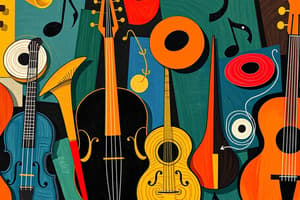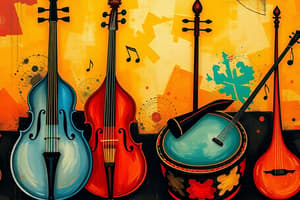Podcast
Questions and Answers
What produces sound in wind instruments?
What produces sound in wind instruments?
- Vibrating strings
- Electronic synthesis
- Vibrating air (correct)
- Striking surfaces
Which of the following is NOT a part of the human voice?
Which of the following is NOT a part of the human voice?
- Larynx
- Soundboard (correct)
- Resonating Chambers
- Vocal Cords
Which instrument produces sound through electronic means?
Which instrument produces sound through electronic means?
- Cello
- Trumpet
- Percussion
- Electric Guitar (correct)
What is the primary method of sound production for string instruments?
What is the primary method of sound production for string instruments?
Which component of the human voice aids in shaping sounds into recognizable speech?
Which component of the human voice aids in shaping sounds into recognizable speech?
How do percussion instruments produce sound?
How do percussion instruments produce sound?
In keyboard instruments, how is sound typically produced?
In keyboard instruments, how is sound typically produced?
Which instrument is an example of a wind instrument?
Which instrument is an example of a wind instrument?
Which type of instrument produces sound through vibrating strings?
Which type of instrument produces sound through vibrating strings?
What is the role of the vocal cords in voice production?
What is the role of the vocal cords in voice production?
Which of the following is considered a wind instrument?
Which of the following is considered a wind instrument?
Which part of the human voice is crucial for forming vowels and consonants?
Which part of the human voice is crucial for forming vowels and consonants?
Which category of instruments includes both tuned and un-tuned types?
Which category of instruments includes both tuned and un-tuned types?
Which part of the human voice amplifies certain sounds and contributes to resonance?
Which part of the human voice amplifies certain sounds and contributes to resonance?
Which instrument type relies on electronic means for sound generation?
Which instrument type relies on electronic means for sound generation?
Which part of the human voice controls airflow for sound production?
Which part of the human voice controls airflow for sound production?
Which of these is an example of a keyboard instrument?
Which of these is an example of a keyboard instrument?
Which group of instruments produces sound through blowing air?
Which group of instruments produces sound through blowing air?
Flashcards are hidden until you start studying
Study Notes
Types Of Musical Instruments
-
String Instruments:
- Sound produced by vibrating strings.
- Examples: Violin, Guitar, Cello.
-
Wind Instruments:
- Sound produced by vibrating air.
- Examples: Flute, Trumpet, Clarinet.
-
Percussion Instruments:
- Sound produced by striking, shaking, or scraping.
- Examples: Drums, Tambourine, Marimba.
-
Keyboard Instruments:
- Sound produced by pressing keys, which may strike strings or pipes.
- Examples: Piano, Organ, Synthesizer.
-
Electronic Instruments:
- Sound produced through electronic means or digital synthesis.
- Examples: Electric Guitar, Theremin, Sampler.
Parts Of The Human Voice
-
Larynx (Voice Box):
- Contains vocal cords; responsible for sound production.
-
Vocal Cords:
- Folds of tissue that vibrate to create sound when air passes through.
-
Resonating Chambers:
- Include throat, mouth, and nasal cavities; amplify and modify sound.
-
Articulators:
- Structures such as tongue, lips, and teeth; shape sounds into recognizable speech or song.
How Instruments Produce Sound
-
Vibration:
- Fundamental principle; sound is produced by vibrating elements (strings, air columns, membranes).
-
String Instruments:
- Strings vibrate when plucked or bowed; body of instrument amplifies sound.
-
Wind Instruments:
- Air is blown into or across a mouthpiece; vibrations create sound waves in the air column.
-
Percussion Instruments:
- Striking causes membranes or solid materials to vibrate, creating sound.
-
Keyboard Instruments:
- Hammers strike strings (piano) or air is pushed through pipes (organ) to produce sound.
-
Electronic Instruments:
- Sound is generated electronically, often through oscillators and synthesizers, creating a wide range of tones.
Types Of Musical Instruments
- String Instruments: Produce sound via vibrating strings. Common examples include Violin, Guitar, and Cello.
- Wind Instruments: Generate sound by forcing air through a medium that vibrates. Notable instruments include Flute, Trumpet, and Clarinet.
- Percussion Instruments: Create sound through being struck, shaken, or scraped. Key examples are Drums, Tambourine, and Marimba.
- Keyboard Instruments: Produce sound by pressing keys, which activate hammers to strike strings or release air through pipes. Examples comprise Piano, Organ, and Synthesizer.
- Electronic Instruments: Generate sound using electronic means or digital synthesis, such as Electric Guitar, Theremin, and Sampler.
Parts Of The Human Voice
- Larynx (Voice Box): Houses the vocal cords and plays a key role in sound production.
- Vocal Cords: Thin folds of tissue that vibrate as air passes through, generating sound.
- Resonating Chambers: Throat, mouth, and nasal cavities modify and amplify sound, influencing tone quality.
- Articulators: Structures like the tongue, lips, and teeth shape vibrations into recognizable speech or musical notes.
How Instruments Produce Sound
- Vibration: The core principle of sound production; occurs through vibrating elements such as strings, air columns, and membranes.
- String Instruments: When strings are plucked or bowed, they vibrate, and the body of the instrument enhances the sound.
- Wind Instruments: Blowing air into a mouthpiece creates vibrations that produce sound waves within the air column.
- Percussion Instruments: Striking an object causes vibrations, either in membranes or solid materials, leading to sound production.
- Keyboard Instruments: Hammers hit strings (in pianos) or air is pushed through pipes (in organs), generating musical tones.
- Electronic Instruments: Utilize electronic circuitry, often involving oscillators, to create various tones and sound effects.
Types of Musical Instruments
- String Instruments: Generate sound by vibrating strings; examples include Violin, Guitar, Cello, Viola, and Harp; played through bowing or plucking.
- Wind Instruments: Produce sound via vibrating air columns; divided into Woodwind (e.g., Clarinet, Flute, Saxophone, Oboe) and Brass (e.g., Trumpet, Trombone, Tuba, French Horn); played by blowing air into or across a mouthpiece.
- Percussion Instruments: Create sound by being struck, shaken, or scraped; examples include Drums, Tambourine, Marimba, and Xylophone; can be classified as tuned (e.g., xylophone) or un-tuned (e.g., drums).
- Keyboard Instruments: Produce sound by pressing keys; include Piano, Organ, Harpsichord, and Synthesizer; may encompass features of both string and percussion instruments.
- Electronic Instruments: Generate sound electronically; examples include Electric Guitar, Synthesizers, and Samplers; frequently utilized in contemporary music genres.
Parts Of The Human Voice
- Lungs: Deliver the essential air supply for voice production; regulate breath control and airflow.
- Vocal Cords (Vocal Folds): Located in the larynx, these vibrate to create sound as air passes through them.
- Larynx: Contains the vocal cords; serves as the sound source with pitch determined by the tension and length of the cords.
- Pharynx: The throat area functions as a resonating chamber; affects the tone quality and volume of the voice.
- Mouth and Tongue: Shape sound through articulation; vital for forming both vowels and consonants.
- Nasal Cavity: Enhances resonance; significant for producing certain sounds and amplification.
- Articulators: Comprising the lips, teeth, tongue, and palate; essential for pronunciation and clarity in speech and singing.
Studying That Suits You
Use AI to generate personalized quizzes and flashcards to suit your learning preferences.




